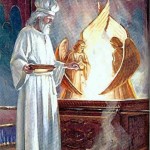
Ancient Israelite temple vestiture and ritual. The High Priest wears his special linen garments, sash and turban during his once per year entry into the Holy of Holies on Yom Kippur, the Day of Atonement. He approaches the Ark of the Covenant beyond the veil with the incense shovel in one hand, the smoke representing the prayers of the Israelites, and small vessel of bull’s blood in the other hand, the sin offering (atonement) on behalf of all the Israelites. Image based on Leviticus 16 and Exodus 25-31 and Exodus 35-40.
Professor William J. Hamblin has offered some good starting points in considering the relationship between the ancient Israelite temple ritual and the modern day LDS temple endowment. It is from this vantage point that we should approach trying to understand these ancient ritual systems and the connections they might have with the Latter-day Saints temple ritual.
“When considering the possible relationship between ancient Israelite temple system and the LDS Endowment, the first thing to note is the basic purpose of the ancient temple was to reconcile Israel with God and bring all Israel (represented by the twelve stones inscribed with the tribal names) back into the presence of God (that is recapitulating the Sinai theophany), symbolically represented by the Holy Place and Holy of Holies within the veil.
“The second thing to note is that Israel had exoteric rituals in the outer courtyard of the temple which could be witnessed by all (though only priests officiated). Esoteric rituals performed inside the temple itself could only be performed and witnessed by priests. LDS Endowment broadly corresponds to the esoteric rituals performed inside the temple, not the exoteric rituals performed outside. The ancient exoteric Israelite temple rituals correspond with the LDS weekly sacrament (the bread/wine offering of the Israelite temple).” (William Hamblin, Mormon Scripture Explorations)
Another important point to realize is that Christ was the last great blood sacrifice when He came in the meridian of time and offered the Atonement, which ended sacrifice by the shedding of blood (3 Ne. 9:19; cf. Mosiah 13:27; Alma 34:13; 3 Ne. 15:2-10). Since Christ was the last blood sacrifice (all precursors pointing to Him), from that point onward the outward nature of sacrificial ritual changed, but still pointing towards Christ, and still a sacrifice of a broken heart and contrite spirit (3 Ne. 9:20-22; Psalms 51:16-17; Psalms 34:18).
See the gallery below for various artists’ depictions of the rituals inside the ancient Israelite temple. Click each image to enlarge.
- Prayer with uplifted hands before the veil
- Sprinkling blood on the mercy seat
- Approaching the ark.
- Prayer before the incense altar, next to the veil.
- Theophany of the Lord on the mercy seat.
- Offering incense on the altar.
- Sprinkling blood on the mercy seat.
- Offering incense on the altar.
- Passing through the veil.
- Offering incense within the Holy of Holies
- Prayer before the altar of incense.
- Sprinkling the atoning blood on the mercy seat.
- Offering incense in the Holy of Holies
- Prayer before the veil, with uplifted hands.
- Approaching the altar of incense and the veil.















I love this. Though I would reiterate that the division between the exoteric and the esoteric *broadly* corresponds to modern worship. There are elements of both (exo & eso) from the ancient world that cross over each other in the modern world.
And If I may — a little plug: It is precisely this kind work (done by Hamblin and others) that helps us discover the beauty and *richness* of LDS texts. I hope we don’t see a “letting up” of sorts on the meticulous study of ancient texts.
I believe this artwork is from Ariel, Israel & Richman, Chaim, Carta’s Illustrated Encyclopedia of the Holy Temple in Jerusalem, The Temple Institute, Carta, Jerusalem, (2005). Should they be credited?
My Mother’s brother converted to Catholicism for his second wife. (My Mother and siblings were raised Southern Baptist. My Mother converted to LDS) He passed away suddenly and unexpectedly. I attended his funeral and a few weeks after the funeral I asked his wife the differences between the Catholic church and the Orthodox. She was not sure of all the differences but told me some things. It was interesting. So was my Uncle’s funeral. The Catholics and Orthodox churches have some remnants/similarities of the ancient Temple ceremonies in their Mass. The Orthodox have a Holy of Holies. During the Mass for my Uncle I could see similarities between the Mass and what we do in the Temple. My Aunt has no idea why Mass is done the way it is or why certain things are used in Mass, and she is very Catholic, born of Irish parents and raised in Catholic Philadelphia. She is very knowledgeable in other areas of Catholicism though. I love the information from ancient texts and grateful to those who study the texts give us this information.